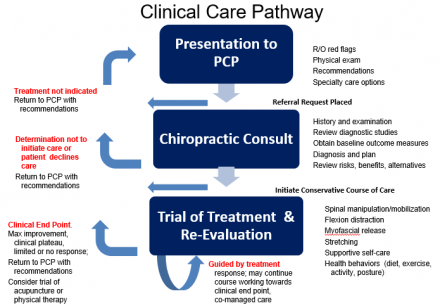Margaret decides to see a chiropractor to discuss pain management options.
TMJ and Chiropractic
The sequence .of initial evaluation, referral for consultation, and repeated assessment of treatment efficacy shown here is a typical clinical care pathway.
Clinical Care Pathway

Patient History
The patient history performed by the chiropractor is similar to that of the primary care provider.
The exception occurs when the level of questioning relates to:
- Neurology
- Spinal function
- Patient mobility and pain
TMJ: History and Examination
During the first visit to the chiropractor’s office a patient can expect a comprehensive history, neurological, orthopedic and chiropractic examination.
This will help to determine if the patient is a candidate for chiropractic treatment.
TMJ: Chiropractic History
For the chiropractic provider the following are some of the most important questions that are included within a TMJ patient history:
- Do you experience pain when you chew? And/or open wide to yawn? And/or use your jaws? Is there any radiation of pain?
- Do you experience pain or soreness in front of the ear?
- Do you experience pain in muscles associated with the jaw?
- And/or cheek? And/or teeth? And/or the temples?
- Does your jaw make noises, such as a popping or clicking?
- Do you ever find it challenging to open your mouth wide?
- When you open your jaw does it ever get stuck or get locked as you open it?
- Do you experience headaches? If yes, describe the quality.
The Chiropractor Reviews Margaret's Patient History
Physical examination focuses on spinal function and patient mobility and pain.
The Chiropractor Examines Margaret
TMJ Examination
The chief complaint on this patient also includes a headache. It is important to assess the cervical spine as well to rule out involvement:
- Cervical Spine ROM
- Cervical Compression Test
- Cervical Distraction Test
- Palpation of Posterior Cervical Musculature, Sternocliedomastoid and Upper Trapezius
Lack of motion or presence of excess motion and pain is being identified in the following examination procedures:
- Mandible ROM
- Observation and palpation of joint line
- Mandible deviation on opening or closing with either a “C”, “Z” or “S” curve
- Palpation of the muscles of mastication (masseter, temporalis, medial/lateral pterygoids)
Reference
Brantingham JW, Cassa TK, Bonnefin D, et al. Manipulative and multimodal therapy for upper extremity and temporomandibular disorders: a systematic review. J Manipulative Physiol Ther. 2013 Mar-Apr;36(3):143-201. Epub 2013 May 20
Chiropractor Discusses Findings and Treatment Options
Treatment
- Manipulation to the tempromandibular joint
- Soft tissue work (cross friction massage) to the muscles of mastication as well as any involved cervical spine musculature
- Heat or Ice to the region
- Potential co-management with Dental provider
- Night guard/grinding
- Clenching of teeth
- Patient Education: Avoid biting on hard or sticky foods, avoid gum chewing
Patient Outcomes with Chiropractic Treatment and TMJ
- Patients tend to progress well with conservative chiropractic treatment
- On average treatment length is 4-6 visits with re-evaluation of patient complaint
- Goal of care is to decrease pain and increase ROM
Reference
Brantingham JW, Cassa TK, Bonnefin D et al. Manipulative and multimodal therapy for upper extremity and temporomandibular disorders: A systematic review. J Manipulative Physiol Ther. 2013 Mar-Apr;36(3):143-201. Epub 2013 May 20.
Patient Profile
Patients that maybe good candidates for care include the following:
- Sub-Acute to Chronic
- Have failed to get better with time
- Have used medications without relief
- Have been a patient of physical therapy and did not find relief
- Use or have used orthodontic appliances
- Acute patients may also be good candidates for care
Reference
Acampora C. Joint Effort. American Chiropractic Association.
U.S. Department of Health and Human Services. TMJ Disorders. NIH Publication No. 13-3487; 2013:1-20.
Spinal and Extra Spinal Manipulation: Maximizing the Benefits
Treatment based on patient goals:
- Decrease Pain
- Increase Mobility
- Stabilize Spine
- Increase Proprioception
References
- Clark B, Gross D. et al. Neurophysiologic effects of spinal manipulation in patients with chronic low back pain. BMC Musculoskelet Disord. 2011 Jul 22;12(1):170
- Learman KE, Myers JB, et al. Effects of spinal manipulation on trunk proprioception in subjects with chronic low back pain during symptom remission. J Manipulative Physiol Ther. 2009 Feb;32(2):118-26.
- Chou R, et al. Diagnosis and treatment of low back pain: a joint clinical practice guideline from the American College of Physicians and the American Pain Society. Ann Intern Med. 2007 Oct 2;147(7):478-91

